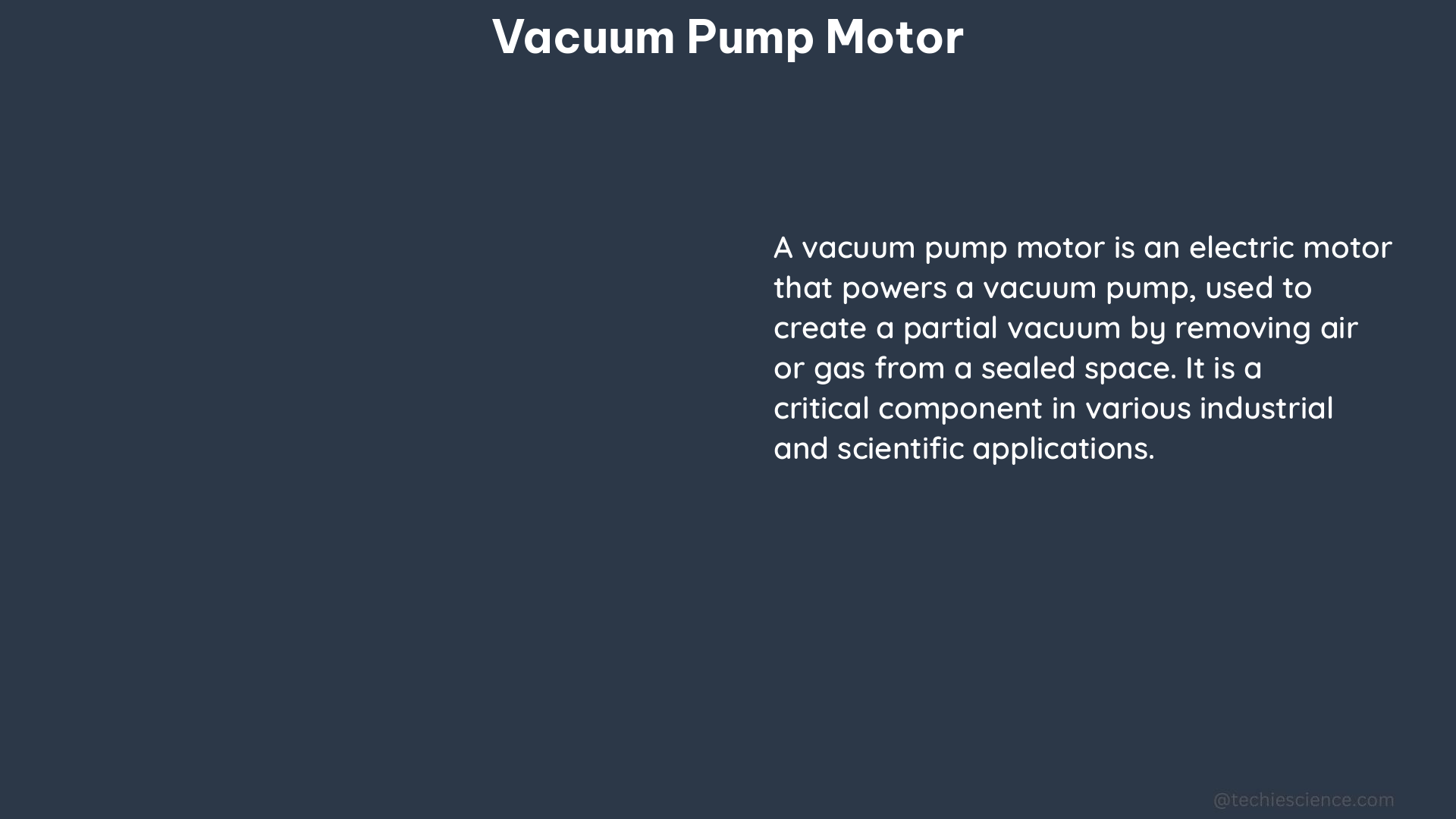The vacuum pump motor is a critical component that drives the mechanical action of a vacuum pump, enabling the removal of gases or vapors from a system. Understanding the intricacies of vacuum pump motor specifications is essential for optimizing the pump’s performance and ensuring its efficient operation.
Power Consumption
Vacuum pump motors typically consume between 0.1 and 5 kW of power, depending on the size and application of the pump. Smaller pumps used in laboratory settings may consume as little as 0.1 kW, while larger industrial pumps can consume up to 5 kW or more. The power consumption of a vacuum pump motor is directly related to the size of the pump and the amount of work it needs to perform. For instance, a larger pump with a higher gas throughput will require a more powerful motor to maintain the necessary suction force.
Speed

The motor’s speed, measured in revolutions per minute (RPM), has a significant impact on the pump’s gas throughput. Higher speed motors generally result in higher gas flow rates, but they can also lead to increased noise levels and energy consumption. The optimal motor speed for a vacuum pump depends on the specific application and the desired performance characteristics. In general, higher speed motors are preferred for applications that require rapid evacuation, while lower speed motors may be more suitable for applications that prioritize energy efficiency or quieter operation.
Efficiency
Motor efficiency, expressed as a percentage, indicates how effectively the motor converts electrical energy into mechanical energy. High-efficiency motors can reduce energy costs and contribute to a more sustainable operation. The efficiency of a vacuum pump motor is influenced by factors such as the motor’s design, materials, and manufacturing processes. Typically, brushless DC (BLDC) motors and permanent magnet synchronous motors (PMSM) offer higher efficiency compared to traditional induction motors.
| Motor Type | Typical Efficiency Range |
|---|---|
| Induction Motor | 80% – 95% |
| BLDC Motor | 90% – 97% |
| PMSM | 92% – 98% |
Torque
The motor’s torque, measured in newton-meters (Nm), determines its ability to overcome resistance and maintain a consistent speed under load. High-torque motors are better suited for applications that require significant force to evacuate the system, such as those with high gas loads or viscous fluids. The required torque for a vacuum pump motor depends on factors like the pump’s size, the system’s resistance, and the desired evacuation rate.
| Pump Size | Typical Torque Range |
|---|---|
| Small (< 1 HP) | 0.5 – 5 Nm |
| Medium (1 – 5 HP) | 5 – 20 Nm |
| Large (> 5 HP) | 20 – 100 Nm |
Service Factor
The service factor is a multiplier that indicates the motor’s ability to handle overloads and maintain performance under demanding conditions. A service factor of 1.0 indicates the motor is designed to operate at its rated power, while a service factor greater than 1.0 indicates the motor can handle overloads. For vacuum pump applications, a service factor of 1.15 or higher is recommended to ensure the motor can withstand temporary overloads and provide a safety margin for unexpected operating conditions.
Enclosure Type
The motor’s enclosure type, such as open, totally enclosed fan-cooled (TEFC), or explosion-proof, affects its durability, efficiency, and suitability for specific applications. Open enclosures are typically used in clean, well-ventilated environments, while TEFC enclosures provide better protection against dust, moisture, and other environmental factors. Explosion-proof enclosures are designed for use in hazardous locations where flammable gases or vapors may be present.
Insulation Class
The insulation class, such as Class A, B, F, or H, determines the motor’s operating temperature range and longevity. Higher insulation classes, such as Class F or H, can withstand higher temperatures and are more suitable for applications with elevated ambient temperatures or high-duty cycles.
Voltage and Frequency
The motor’s voltage and frequency requirements, typically specified in volts (V) and hertz (Hz), must match the power supply to ensure proper operation. Vacuum pump motors are commonly available in single-phase or three-phase configurations, with voltages ranging from 115 V to 480 V and frequencies of 50 Hz or 60 Hz. Ensuring the correct voltage and frequency is crucial to avoid damage to the motor and maintain optimal performance.
Mounting Type
The motor’s mounting type, such as foot-mounted, flange-mounted, or C-face, affects how it is installed and integrated with the vacuum pump. The mounting type should be compatible with the pump’s design and the available space in the installation location.
Life Expectancy
The motor’s life expectancy, measured in hours, indicates its expected service life under normal operating conditions. Factors such as the motor’s design, materials, and maintenance practices can influence its lifespan. Proper maintenance, including regular inspections, lubrication, and timely replacement of worn components, can help extend the motor’s life expectancy.
By understanding these technical specifications, DIY enthusiasts can make informed decisions when selecting, installing, and maintaining vacuum pump motors. This knowledge can help optimize the pump’s performance, reduce energy consumption, and ensure reliable operation over the long term.
References:
– ISO 14 830-1:2019, Condition monitoring and diagnostics of machine systems — Tribology-based monitoring and diagnostics — Part 1: General requirements and guidelines.
– HVAC-Talk, Vacuum pump CFM, does it matter?
– OOMWF, Mechanical Vacuum Pumps Market Size | Statistics Report 2032.
– Baldor Electric Company, Vacuum Pump Motor Selection Guide.
– Leybold, Vacuum Pump Motor Efficiency and Life Expectancy.
– Pfeiffer Vacuum, Vacuum Pump Motor Specifications and Considerations.

The lambdageeks.com Core SME Team is a group of experienced subject matter experts from diverse scientific and technical fields including Physics, Chemistry, Technology,Electronics & Electrical Engineering, Automotive, Mechanical Engineering. Our team collaborates to create high-quality, well-researched articles on a wide range of science and technology topics for the lambdageeks.com website.
All Our Senior SME are having more than 7 Years of experience in the respective fields . They are either Working Industry Professionals or assocaited With different Universities. Refer Our Authors Page to get to know About our Core SMEs.